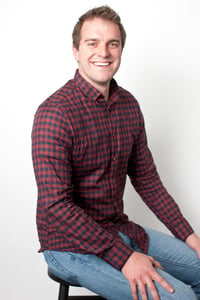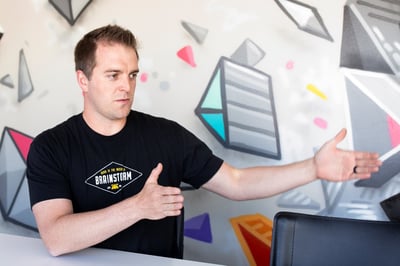Change management is a hot topic right now, and understandably so. But it’s a tough topic to fully wrap your head around.
To shed further light on the subject, I recently sat down with an change expert: BrainStorm’s own Chandler Milne.

Chandler is a certified Prosci Change Practitioner who seems to live and breathe change – he’s even earned the nickname ‘Changeler’ here at BrainStorm. You can often find him building something new for his desk or shifting the layout of his office space. “I’m the kind of person who needs change to regularly infuse my life with new energy and ideas,” he says.
I asked Chandler about his experience with organizational change and his thoughts on the most important steps to follow in the change process.

CM: Put this on the record: don’t make me sound stupid.
AA: (Laughs)—I’ll try my hardest. So, Chandler, how long have you been an advocate for change?
CM: I’m the kind of person who needs change to create some kind of energy in my life. I’ll move furniture around in my house every once in a while, move desks at work, and create new things. As I’ve gotten into the change discipline more and more, I’ve been able to understand some of my personality and this weird energy that is change.
AA: That’s a great introduction to change.
CM: And we’re done, right?
AA: Yep, that’s it. Thank you for coming in. Ha! Just kidding—I do have a few more questions for you. If you had to define change management in your own words, how would you describe it?
CM: For me, change management is really a structured approach to creating or inspiring change for people—aligning people, processes, and tools to make change possible. At BrainStorm, we opt for the term change enablement because ‘management of change’ gives a perception that it’s something that can be managed. But change is more inspired and sparked and directed than it is managed.
AA: Let’s say someone came up to you and you only had a few minutes to tell them what to focus on when initiating a change in their organization. What are the biggest things that they should focus on when starting a change initiative?
CM: Adoption and change enablement, in BrainStorm’s perspective, has three main steps: vision, plan, and scale.
-
Vision: First, I have to create some organizational desire for this change. How does change map to organizational goals and initiatives? How does this help my executive team or my sponsorship group? Are they willing to participate? Does the organization actually care to make this a reality, and is it impactful? A successful change all starts with a common desire.
-
Plan: Next you need to focus your direction. The number one reason for resistance in times of change is lack of clarity, or what we call “What’s in it for me?” Now that we know what we want to be or where we want to go, what does that path start to look like?
For example, a more technically literate organization works more efficiently and empowers employees to do really cool things with their customers. That might mean changing a certain number of skill sets in our organization. Let’s focus on those skillsets and create a plan to implement those behaviors in the organization.
- Scale: Once you’ve nailed the plan, then you drive meaningful scale to your tens, hundreds, or thousands of users so that that vision ultimately becomes reality (or at least closer to reality).
AA: You mentioned generating executive sponsorship. How would you advise someone on how to get that?
CM: Executives are asked to sponsor a lot of initiatives in their organization. So, spend time helping an executive connect their and the organization’s goals to the changes you want to make. As an executive, I might be charged with changing the cost structure of the organization or increasing market share. Can you help me with that? And if you can, I’m more likely to trust in this and buy into this.
AA: In your experience, what is the biggest mistake you see organizations make when they’re approaching change?
CM: There are a lot, but one of the biggest blunders is that an organization approaches change as a technology problem rather than a people problem. The issue with approaching change as a technology problem is that organizations are always trying to cut costs, and technology is generally an area where you want to save.
Another challenge that we see is change fatigue. Organizations need to appreciate how frequently change is happening for their end users and employees and take appropriate action to mitigate the risks and consequences of that. They need to understand change, be more clear, prioritize initiatives, and connect change to real business objectives.

AA: On the flipside, can you describe an example of an organization that you’ve seen or worked with that has excelled at change—and highlight why they did so well?
CM: One of my favorites is a manufacturing organization that I’ve had the opportunity to work with. Most organizations hand off these types of (technology) projects to the IT team. They’ll do the work, but they usually realize a few weeks before launch that they need to tell users about what’s coming. It becomes a last-minute scramble for the most important element of your campaign—actually getting people to use the technology.
Anyway, this manufacturer did things differently. All the technical resource and project-oriented teams were one leg of the project, and the change and people-oriented team were the other. Both groups were able to coordinate better with leadership in kind of a triangular fashion—and all three parties were at the same table representing key parts of this project.
Now, the whole organization is taking a more holistic approach to change. They’re preparing themselves better for their deployments, and subsequently, for their bigger picture adoption and transformation.
AA: So, if someone were looking to learn more about change and change management what are some resources that you’d recommend?
CM: I have a few favorite resources for learning about change. My favorite book is Switch by the Heath brothers. Their method is a little bit more oriented towards individual change management, but there are some strong ties to organizational change that have validated BrainStorm’s methodology or made their way into it.
Microsoft has spent a lot of time producing some really cool, pragmatic resources around change within Office 365 and Windows. Prosci is a thought leader in the space, and I’ve enjoyed learning from them and the context that they provide. And of course, the internet is a cave of wonders. There’s some pretty incredible stuff out there if you know where to look.
AA: So that’s all the questions I had for you. Is there anything that you want to add or anything that you think that we missed? Sort of a final mic-drop?
CM: Change can be hard. It’s probably not as complex as we might think it is, but it can be challenging. I think the real difference between organizations that struggle with change and those that don’t is intent. If you want to be good at change, you have to pay attention to it. Spend the time and energy necessary to do change well, and you’ll reap the reward of that intention and that action.
AA: Well, thank you so much for chatting with me.
CM: No problem! Any time.
For the latest and greatest on change enablement, follow Chandler Milne on LinkedIn.
For more on digital transformation and change, follow BrainStorm on Twitter, LinkedIn, and Facebook


